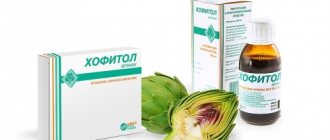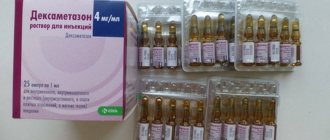Nosological classification (ICD-10)
- A48.3 Toxic shock syndrome
- A49 Bacterial infection of unspecified localization
- C71 Malignant neoplasm of the brain
- C80 Malignant neoplasm without specification of localization
- C82 Follicular [nodular] non-Hodgkin's lymphoma
- C83 Diffuse non-Hodgkin's lymphoma
- C84 Peripheral and cutaneous T-cell lymphomas
- C85 Other and unspecified types of non-Hodgkin's lymphoma
- C95 Leukemia of unspecified cell type
- C95.0 Acute leukemia of unspecified cell type
- C95.9 Leukemia, unspecified
- D59 Acquired hemolytic anemia
- D69.3 Idiopathic thrombocytopenic purpura
- D70 Agranulocytosis
- E06.1 Subacute thyroiditis
- E27.1 Primary adrenal insufficiency
- E27.2 Addison's crisis
- E27.4 Other and unspecified adrenal insufficiency
- E83.5.0* Hypercalcemia
- G00 Bacterial meningitis, not elsewhere classified
- G04 Encephalitis, myelitis and encephalomyelitis
- G93.6 Cerebral edema
- H01.0 Blepharitis
- H10.1 Acute atopic conjunctivitis
- H10.5 Blepharoconjunctivitis
- H15.0 Scleritis
- H15.1 Episcleritis
- H16.2 Keratoconjunctivitis
- H16.8 Other forms of keratitis
- H20.9 Iridocyclitis, unspecified
- H45.1 Endophthalmitis in diseases classified elsewhere
- I61 Intracerebral hemorrhage
- J40 Bronchitis, not specified as acute or chronic
- J44 Other chronic obstructive pulmonary disease
- J45 Asthma
- J46 Status asthmaticus
- J98.8.0* Bronchospasm
- L30.9 Dermatitis, unspecified
- L91.0 Keloid scar
- L92.0 Granuloma annulare
- L93.0 Discoid lupus erythematosus
- M35.9 Systemic connective tissue disorders, unspecified
- M79.0 Rheumatism, unspecified
- Q89.1 Malformations of the adrenal gland
- R57.8.0* Burn shock
- R57.9 Shock, unspecified
- S05.9 Injury to unspecified part of eye and orbit
- S06 Intracranial injury
- S09 Other and unspecified head injuries
- T78.2 Anaphylactic shock, unspecified
- T78.4 Allergy, unspecified
- T79.4 Traumatic shock
- T90.4 Consequences of injury to the eye, periorbital region
- Z100* CLASS XXII Surgical practice
- Z51.0 Radiotherapy course
- Z94.7 Presence of a transplanted cornea
Dexamethasone solution for injection 4 mg/ml 1 ml ampoule 25 pcs. in Moscow
From the endocrine system
:
decreased glucose tolerance, steroid diabetes mellitus or manifestation of latent diabetes mellitus, suppression of adrenal function, Itsenko-Cushing syndrome (moon-shaped face, pituitary-type obesity, hirsutism, increased blood pressure, dysmenorrhea, amenorrhea, muscle weakness, stretch marks), delayed sexual development in children.
From the digestive system
:
nausea, vomiting, pancreatitis, steroid ulcer of the stomach and duodenum, erosive esophagitis, gastrointestinal bleeding and perforation of the wall of the gastrointestinal tract, increased or decreased appetite, indigestion, flatulence, hiccups.
In rare cases, increased activity of liver transaminases and alkaline phosphatase. From the cardiovascular system
:
arrhythmias, bradycardia (up to cardiac arrest);
development (in predisposed patients) or increased severity of heart failure, changes in the electrocardiogram characteristic of hypokalemia, increased blood pressure, hypercoagulation, thrombosis. In patients with acute and subacute myocardial infarction - the spread of necrosis, slowing down the formation of scar tissue, which can lead to rupture of the heart muscle. From the nervous system
:
delirium, disorientation, euphoria, hallucinations, manic-depressive psychosis, depression, paranoia, increased intracranial pressure, nervousness or anxiety, insomnia, dizziness, vertigo, pseudotumor of the cerebellum, headache, convulsions.
From the senses
:
posterior subcapsular cataract, increased intraocular pressure with possible damage to the optic nerve, tendency to develop secondary bacterial, fungal or viral eye infections, trophic changes in the cornea, exophthalmos, sudden loss of vision (with parenteral administration in the head, neck, nasal turbinates, scalp possible deposition of drug crystals in the blood vessels of the eye).
Metabolism
:
increased calcium excretion, hypocalcemia, weight gain, negative nitrogen balance (increased protein breakdown), increased sweating.
Caused by mineralocorticoid activity - fluid and sodium retention (peripheral edema), hypsarnatremia, hypokalemia syndrome (hypokalemia, arrhythmia, myalgia or muscle spasm, unusual weakness and fatigue). From the musculoskeletal system
:
slower growth and ossification processes in children (premature closure of the epiphyseal growth plates), osteoporosis (very rarely - pathological bone fractures, aseptic necrosis of the head of the humerus and femur), rupture of muscle tendons, steroid myopathy, decreased muscle mass (atrophy).
From the skin and mucous membranes
:
delayed wound healing, petechiae, ecchymoses, skin thinning, hyper- or hypopigmentation, steroid acne, stretch marks, tendency to develop pyoderma and candidiasis.
Allergic reactions
:
skin rash, itching, anaphylactic shock, local allergic reactions.
Local
:
with parenteral administration: burning, numbness, pain, tingling at the injection site, infection at the injection site, rarely - necrosis of surrounding tissues, scarring at the injection site;
atrophy of the skin and subcutaneous tissue with intramuscular injection (injection into the deltoid muscle is especially dangerous). Others
:
development or exacerbation of infections (the appearance of this side effect is facilitated by jointly used immunosuppressants and vaccination), leukocyturia, flushing, withdrawal syndrome.
Directions for use and doses
IV, slow stream or drip (in acute and emergency conditions); i/m; local (into the pathological formation) administration is also possible.
The dosage regimen is individual and depends on the indications, the patient’s condition and his response to therapy.
To prepare a solution for intravenous drip infusion, you should use an isotonic sodium chloride solution or a 5% dextrose solution.
In the acute period for various diseases and at the beginning of therapy, Dexamethasone is used in higher doses. During the day, you can administer from 4 to 20 mg of Dexamethasone 3-4 times.
Doses of the drug for children (i.m.)
When carrying out replacement therapy (for adrenal insufficiency) - 0.0233 mg/kg or 0.67 mg/m2, divided into 3 doses, every 3rd day or 0.00776–0.01165 mg/kg or 0.233–0.335 mg/m2 daily. For other indications, the recommended dose is 0.02776 to 0.16665 mg/kg or 0.833 to 5 mg/m2 every 12 to 24 hours.
When the effect is achieved, the dose is reduced to maintenance or until treatment is stopped. The duration of parenteral use is usually 3-4 days, then switch to maintenance therapy with Dexamethasone tablets.
Long-term use of high doses of the drug requires a gradual dose reduction in order to prevent the development of acute adrenal insufficiency.
Dexamethasone-VIAL
Glucocorticosteroid (GCS) is a methylated derivative of fluorprednisolone, inhibits the release of interleukin-1, interleukin-2, interferon gamma from lymphocytes and macrophages.
It has anti-inflammatory, antiallergic, desensitizing, antishock, antitoxic and immunosuppressive effects.
Suppresses the release of adrenocorticotropic hormone (ACTH) and beta-lipotropin by the pituitary gland, but does not reduce the content of circulating beta-endorphin. Inhibits the secretion of thyroid-stimulating hormone (TSH) and follicle-stimulating hormone (FSH).
Increases the excitability of the central nervous system (CNS), reduces the number of lymphocytes and eosinophils, increases the number of red blood cells (stimulates the production of erythropoietins).
Interacts with specific cytoplasmic receptors and forms a complex that penetrates the cell nucleus and stimulates mRNA synthesis; the latter induces the formation of proteins, incl. lipocortin, mediating cellular effects. Lipocortin inhibits phospholipase A2, suppresses the release of arachidonic acid and suppresses the synthesis of endoperoxides, prostaglandins, leukotrienes, which contribute to inflammation and allergies.
Protein metabolism:
reduces the amount of protein in plasma (due to globulins) with an increase in the albumin/globulin ratio, increases the synthesis of albumins in the liver and kidneys; enhances protein catabolism in muscle tissue.
Lipid metabolism:
increases the synthesis of higher fatty acids and thyroglobulin (TG), redistributes fat (accumulation of fat mainly in the shoulder girdle, face, abdomen), leads to the development of hypercholesterolemia.
Carbohydrate metabolism:
increases the absorption of carbohydrates from the gastrointestinal tract (GIT); increases the activity of glucose-6-phosphatase, leading to an increase in the flow of glucose from the liver into the blood; increases the activity of phosphoenolpyruvate carboxylase and the synthesis of aminotransferases, leading to the activation of gluconeogenesis.
Water-electrolyte metabolism:
retains sodium ions and water in the body, stimulates the excretion of potassium ions (mineralocorticosteroid activity), reduces the absorption of calcium ions from the gastrointestinal tract, “washes out” calcium ions from the bones, increases the excretion of calcium ions by the kidneys.
Anti-inflammatory effect
associated with inhibition of the release of inflammatory mediators by eosinophils; inducing the formation of lipocortin and reducing the number of mast cells that produce hyaluronic acid; with a decrease in capillary permeability; stabilization of cell membranes and organelle membranes (especially lysosomal ones).
Antiallergic effect
develops as a result of suppression of the synthesis and secretion of allergy mediators, inhibition of the release of histamine and other biologically active substances from sensitized mast cells and basophils, a decrease in the number of circulating basophils, suppression of the development of lymphoid and connective tissue, a decrease in the number of T- and B-lymphocytes, mast cells, a decrease sensitivity of effector cells to allergy mediators, inhibition of antibody formation, changes in the body's immune response.
In chronic obstructive pulmonary diseases (COPD), the action is based mainly on inhibition of inflammatory processes, inhibition of development or prevention of swelling of the mucous membranes, inhibition of eosinophilic infiltration of the submucosal layer of the bronchial epithelium, deposition of circulating immune complexes in the bronchial mucosa, as well as inhibition of erosion and desquamation of the mucous membrane . Increases the sensitivity of beta-adrenergic receptors of small and medium-caliber bronchi to endogenous catecholamines and exogenous sympathomimetics, reduces the viscosity of mucus by inhibiting or reducing its production.
Antishock and antitoxic effect
is associated with an increase in blood pressure (BP) (due to an increase in the concentration of circulating catecholamines and restoration of the sensitivity of adrenergic receptors to them, as well as vasoconstriction), a decrease in the permeability of the vascular wall, membrane protective properties, and activation of liver enzymes involved in the metabolism of endo- and xenobiotics.
Immunosuppressive effect
caused by inhibition of the release of cytokines (interleukin-1 and interleukin-2, interferon gamma) from lymphocytes and macrophages.
Suppresses the synthesis and secretion of ACTH and, secondarily, the synthesis of endogenous corticosteroids.
Inhibits connective tissue reactions during the inflammatory process and reduces the possibility of scar tissue formation.
The peculiarity of the action is significant inhibition of pituitary function and the almost complete absence of mineralocorticosteroid activity.
Doses of 1-1.5 mg/day inhibit the adrenal cortex; biological half-life is 32-72 hours (duration of suppression of the hypothalamic-pituitary-adrenal system).
In terms of the strength of glucocorticosteroid activity, 0.5 mg of dexamethasone corresponds to approximately 3.5 mg of prednisone (or prednisolone), 15 mg of hydrocortisone or 17.5 mg of cortisone.






